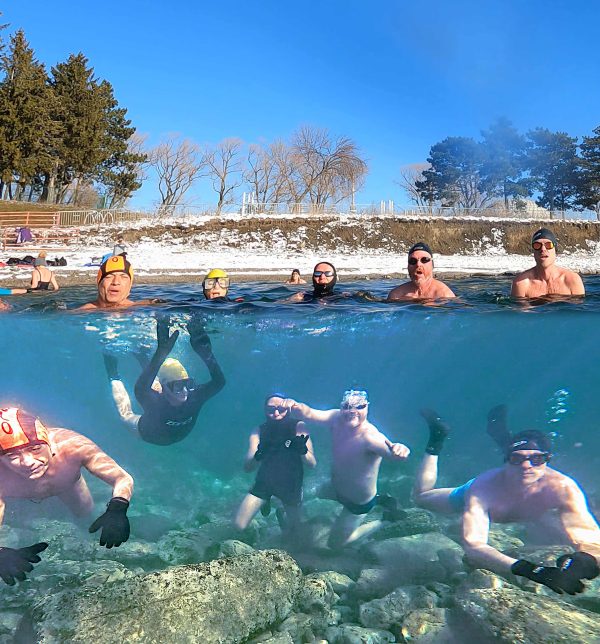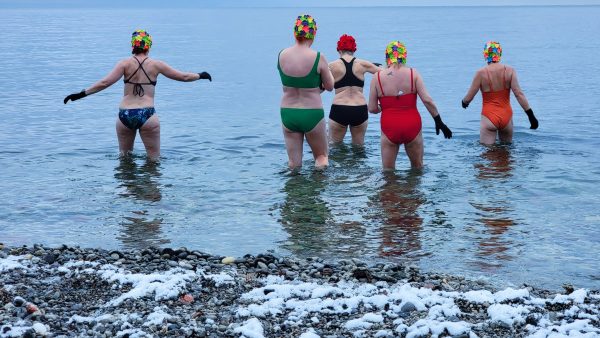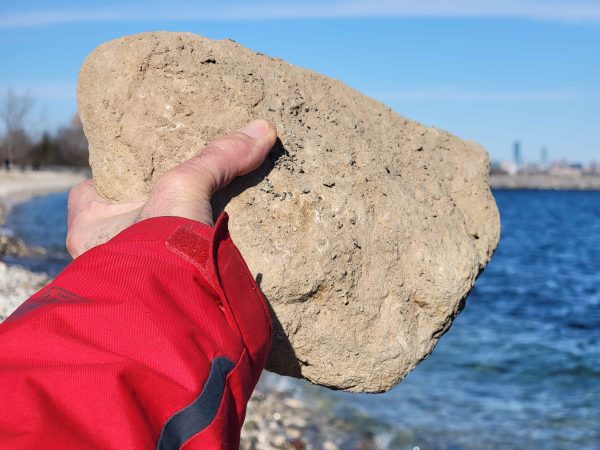I’m one of many who swim and paddle in downtown Toronto year-round. I have no summer cottage. The beach is my cottage.
Until our last swim on January 7th, 2024, we swam nearly every day year-round at Michael Hough Beach, Ontario Place West Island. It is now closed for development. This fine pebble beach has been our joy and pleasure for more than 50 years. It looks pretty much the same as it did in my childhood, except that the trees are much larger now. It is Toronto’s cleanest and most accessible beach. Many of us prefer the fine pea-sized pebbles to sand, as you don’t need to put down a towel or blanket — you can just lay on the pebbles like a giant beanbag bed.
What will “development” do to our fine pebble beach?
Let’s compare the original West Island, as yet untouched by developers, with the Ontario Place East Island, recently developed into Trillium Park. Trillium Park is wonderful but for the water’s edge, which is the reason many of us go there. Instead of nice beaches, the entire shoreline perimeter is buttressed by big rocks, making it dangerous for swimmers and paddlers alike.
For safety, especially when the water is colder, we paddle close to the shore and stop to take frequent rests and check the safety of our vessels. But getting out of the water along these large slippery rocks is treacherous.
The massive number of condominiums along the waterfront puts additional strain on our scarce green and blue space, and we need more, not fewer, clean beaches. At the same time, we have a massive problem with a Combined Sewer Outfall (CSO) at Sunnyside beach behind the breakwall, making it is often unswimmable. Likewise the large sewage treatment plant in the east end often makes Ashbridges Bay, Woodbine, and Cherry Beach unswimmable. So we look to natural beaches further from the mainland.
Many of us with disabilities or mobility issues are also looking for accessible (e.g. fine pebbles rather than sand) beaches as alternatives to the now-closed Ontario Place West Island. Several members of our swim group, SwimOP.com = Swim at Ontario Place, are now swimming at Humber Bay Park. But that series of beaches is also being bouldered over.
While perhaps well-meaning, the city’s consultants and advisors are often not users of recreational water. Their idea of water access means being able to have a footpath that comes close to the lake, but not actually getting into and out of the lake. If all we want to do is look at the lake, we can do that with a VR (Virtual Reality) headset. But one thing we can’t do in VR is jump in the lake and go for a swim or paddle or jump into a ball and run around on the lake.
What about the new Don River developments? I’ve been running the Waterhci = Water-Human-Computer Interface Symposium for 26 years and we invite speakers from around the world to talk about the intersection of water, humans, and technology. The Symposium brings together thought leaders from MIT, Stanford, University of Toronto, and elsewhere working at the intersection of the physical, virtual, and social worlds. I invited Waterfront Toronto to come and talk about their new development. They seemed interested until they asked what I wanted them to talk about. I said I wanted them to talk about the new beach they plan to build. They then immediately declined.
The City could do a lot to improve water access. Take a look at the condition of safety egress ladders, for example. They’re in a state of disrepair. I’ve tried talking to many people at the City and attended meetings at City Hall to present the problem in deputations, and the like, but have been unable to get a meaningful response regarding the state of the safety ladders.
Will it take a tragedy or death for the City to respond?
As more and more of our beaches are sold or leased to private developers or bouldered over, we have more and more people packed into fewer and fewer remaining beaches. This leads to overcrowding, and loss of water access at a time when the city’s population is expanding and its density is increasing.
We don’t want to be packed into little roped-off swim areas, or to buy tickets to swim in a concrete bowl. As Kate Rew said so eloquently: “We do not want to queue up and pay for a swim, we want to swim as people walk: at 5am, for three minutes, at midnight, for hours.”
Ontario Place was supposed to be the “cottage for people without cottages,” but now that it is under private development, and likely closed for years of construction, where do we swim?
Water access is a basic need and a basic human right. It is time to make it safer rather than destroying it or making it more dangerous.
A number of us have decided to engage in a water-access and water safety campaign to raise awareness with a series of “swim ins,” “paddle ins” and “ball ins” at public fountains and basins, as well as sunbathing in the city away from beaches, to get the message across.
Give us a safe place to swim, and a place to paddle in downtown Toronto!
Steve Mann is a Fellow of the IEEE and a Full Professor at University of Toronto. He invented HDR (High Dynamic Range) imaging, the smartwatch, wearable technology, and the hydraulophone (underwater pipe organ). He also founded the new field of Water-Human-Computer Interaction (WaterHCI.com). Join him at facebook.com/groups/swimop






9 comments
This is another terrific example of the poor project planning processes in evidence at all levels of government as it related to the experience of end users. From beaches to boulders, in developing software solutions, stories abound of basic errors in project execution. The basic question of who is using the space/area/product is either poorly understand or barely considered. This isn’t rocket science. As the project sponsor of more than thirty software development projects in my working life, nearly all of which were delivered on time, at cost, and met user needs, the answer is clear. Develop a deep understanding of the needs of the end users, and ensure that the proposed solution delivers an improved experience. It this case, we’re talking about a waterfront park. How did they miss the fact that swimming, wading, and immersive recreation was an essential part of the experience. The mind boggles!
Toronto is blessed as a city to have kilometers and kilometers of shoreline from the Scarborough Bluffs to Etobicoke’s shores. For a city that strives to be world-class, it’s politicians and urban planners have continued to miss the opportunity to create safe and clean access for all recreational water users along the entire shoreline.
Several redevelopment projects in the city illustrate the problem. Prime example, Ontario Place’s West Island has been closed with no alternate access for recreational water users (swimmers, paddleboards, etc). This was ‘downtown’ Toronto’s ONLY public beach which has displaced thousands of people who regularly accessed the water year round for swimming and other activities. Activities that were ‘free’ in a city where the cost of living has significantly risen.
The bouldering at Humber Bay East is another example of making beaches unsafer for users.
The new Portland’s development contains no features for swimming either. And the new Leslie Lookout Park boasts about its beach in promotions but there is no access to the water for any recreational activities.
Toronto also needs to speed up improvements to it’s aging CSO structures which contribute to dangerous levels of e.coli in the Lake.
Mental health issues are also on the rise, access to nature and activities in the outdoors are often a crucial components of wellness treatments. In particular, many seek the water as part of their therapies, like cold water to reset their nervous systems. Countries such as Finland and Sweden, place an emphasis on safe access to water year round contributing to these places ranking among the happiest in the world.
If Toronto truly wants to be world class, it needs to improve safe and clean access along it’s incredible waterfront.
Thank you for the article, you are absolutely right.
Glad to see you’re still writing Steve I completely agree
Meeting other people and swimming together at Ontario place was such a joy for me – I hadn’t realized it was possible to swim so relatively close to my house. The more access to the water we we have, year round, the more we come together. And the more people use our waterfront, the more people value and contribute to it. I really appreciate your advocacy and writing about how to safeguard access.
This pebble beach is one of the best gems of Toronto and it actually reflects Ontario. We bring all our visiting friends here and they are impressed this lush waterfront park and beach exists. Clean urban beaches are special and rare. This is a tourist destination. The future is green – anyone who doesn’t understand this is sadly living in the past. Tax payers do NOT want a billion dollars of OUR money used for corporate welfare for this dubious Austrian company. Therme has only been around for about 10 yrs. & no one even knows the source of their funding. The whole thing is a sketchy disaster from start to finish.
Steve Mann makes some really important points in this article. Toronto is blessed to be situated on the shores of a freshwater inland sea. But city planners are making the waterfront inaccessible for swimmers, kayakers and stand-up paddlers. Landscape architect Michael Hough, the designer of the pebble beach on the West Island of Ontario Place, was brilliant. We need more clean pebble beaches on the Toronto waterfront. Please forward this article to Mayor Chow and your councillor.
Access to the waterfront should always include safe access to the water, and Steve points out that development of Toronto’s waterfront, even when well intentioned, misses that point.
Archival images of the Toronto waterfront show natural beaches thronged with swimmers and bathers, taking advantage of access to the water that is often less available today.
And as beaches can be made still more accessible by creating fine pebble beaches, planners and agencies should integrate that thinking into their designs. Could erosion on Gibraltar Point be better managed by fine pebble beach than by underwater berms? I never heard that idea discussed, yet it might be a very worthwhile approach as shielding shores is still needed at many locations along the waterfront.
Thank you Steve, for continuing to advocate for safe, clean and accessible public lake access – this is how I learned about the water on the West Island at Ontario Place, and as a regular user of the park, it totally changed how I viewed the site.
It’s clear that the Therme Group plan for West Island completely disregards the careful thought and use of the pebble beach. The proposed beach orientation and planned close proximity to a CSO learns so many unanswered questions and concerns.